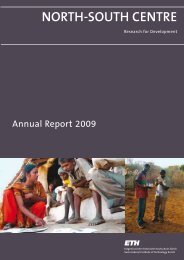Annual Report 2006/07 - ETH - North-South Centre North-South ...
Annual Report 2006/07 - ETH - North-South Centre North-South ...
Annual Report 2006/07 - ETH - North-South Centre North-South ...
You also want an ePaper? Increase the reach of your titles
YUMPU automatically turns print PDFs into web optimized ePapers that Google loves.
ZIL research project, Phase IVProject LeadersHans-Dieter Hess, ALP /Michael Kreuzer / Emmanuel FrossardContact PersonTassilo TiemannCollaboratorsJuan E. Carulla, Barbara Moreno, Univ. Nacionalde Colombia / F. Holmann, C. Lascano, M. Peters,M. Pabón, CIAT, Colombia / Fernando Rodríguez,Corpoica, Colombia / Carla Riccarda Soliva,Hans-Rudolf Wettstein, <strong>ETH</strong> ZurichDurationJanuary 2004 – December <strong>2006</strong>ZIL research projectsLivestocksystemsresearchFeeding strategiesThe forage potential of tanniniferous legumes:Search for sustainable ways to cope withnutritional limitations in smallholder livestockA large variety of tropical tree and shrub legume species withpotential as forage plants in regions with acidic soils exists.However, many of these species contain tannins which mightadversely affect their quality as animal feed but seem toenhance their agronomic performance under biotic and abioticstress compared to non-tanniniferous species.Environmental factors including soil fertility might be importantfor the feeding value as they seem to influence typeand concentration of tannins and other plant properties.Two experiments with cattle and sheep conducted in <strong>2006</strong>gave insight to feed intake and production data of animalssupplemented with those tanniniferous shrub legumes(Calliandra and Flemingia), which had previously shownpromising results in vitro. In dairy cows, milk production significantlyincreased when small amounts of the high qualitylegume Vigna unguiculata (cowpea) were included in a supplementmainly based on a tanniniferous legume (e.g.Calliandra). Such an improved system might be considered,where farmers could grow small amounts of high qualitylegumes, which is relatively time-consuming and costly, andmix these with a high percentage of well-growing tanniniferouslegumes to supplement dairy cattle. The respiratoryexperiment conducted with growing sheep demonstratedthat supplementation with tanniniferous legumes significantlydecreases methane emission compared to diets withoutsuch legumes.A total of over 60 students, technicians and scientists participatedin the final project workshop conducted to communicatethe results of this research.During the last three years we conducted a field study withfive promising shrub legumes with and without tannins(Calliandra calothyrsus, Flemingia macrophylla, Leucaena leucocephala,Desmodium velutinum, Cratylia argentea) on twosoil types with contrasting fertility and various fertilisationlevels. Large differences in plant properties were observedbetween species, sites, fertilisation levels and seasons. Theevaluated properties were growth performance, biomassproduction, forage in vitro degradation dynamics, fiber andmineral composition, tannin content and tannin composition,and their biological activity. All of these plant propertieswere influenced by one or more of the above-mentioned factors.Sheep housed in respiratory chambers in order to assess forage quality and effects onmethane emission35
















